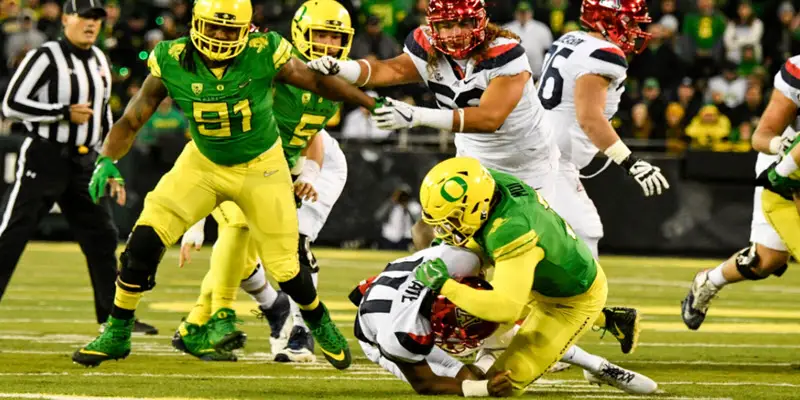Welcome to a special edition of X’s vs. O’s! Whether you are a die-hard Oregon Duck fan or a casual observer, I don’t think anyone expected Oregon to keep pace with Arizona in their November 18th showdown. To come away with such an emphatic victory is even more impressive.
The defensive game-plan deserves much of the credit, and is worth studying. Today, we will be discussing an alignment, as well as, a specific technique Oregon utilized to successfully slow down the vaunted Arizona offense. The alignment is an Eagle front, and Squeeze-N-Pop is the name of the technique that took an extraordinary running quarterback for the Wildcats out of the game.
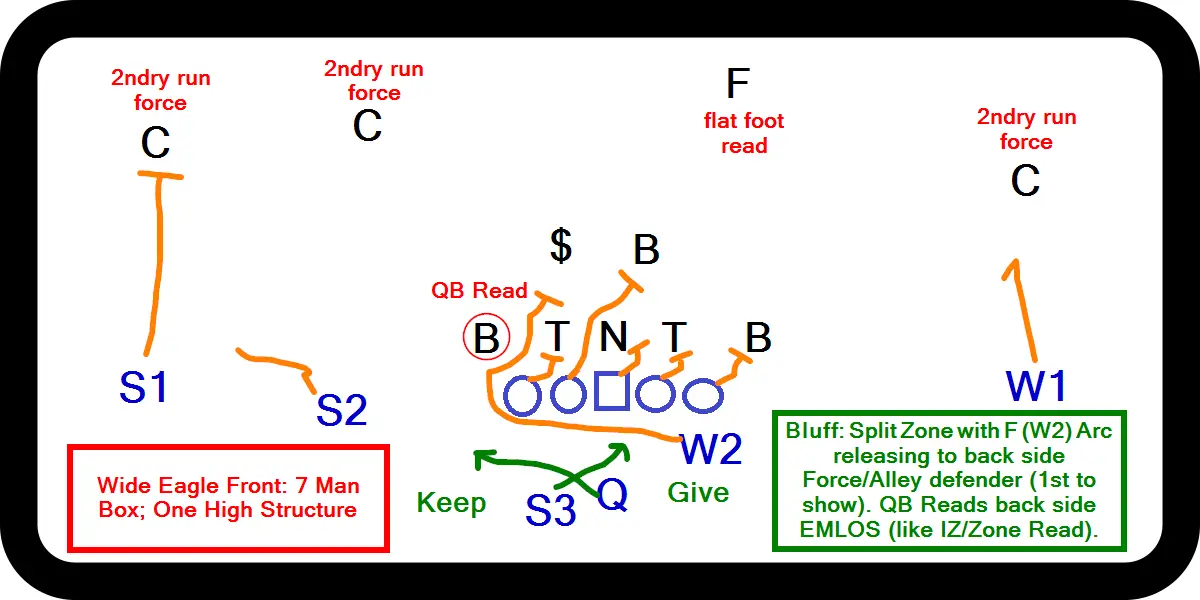
X’s vs. O’s: Wide Eagle vs. Bluff.
First, let’s talk alignment. Above, Oregon shows a “Wide Eagle” front against Arizona’s two-back formation. An Eagle front consists of a nose tackle head-up over the center, two defensive tackles on the inside shoulder of the offensive tackle, and two outside linebackers aligned head-up over the tight end (or imaginary tight end). Typically, the inside backers align 4-6 yards deep on the outside shoulder of the guards. The Wide Eagle front simply widens the alignment of the two outside backers on the line of scrimmage (LOS).
Now, let’s discuss the Squeeze-N-Pop tactic. At the snap, the backside EMLOS (End Man on the Line of Scrimmage) attacks the “mesh point,” where the QB and running back are exchanging the football. He must maintain balance and the proper leverage, as he is ultimately responsible for the QB in this assignment. This requires athleticism, discipline, and considerable body control.
Against the Wildcats, the goal of the Squeeze-N-Pop was to force Arizona’s dynamic QB, Khalil Tate, to hand the ball off to the running back (a give read), thus eliminating the ‘Cat’s most explosive play-maker. In that scenario, the EMLOS would be responsible for containment on any cut back.
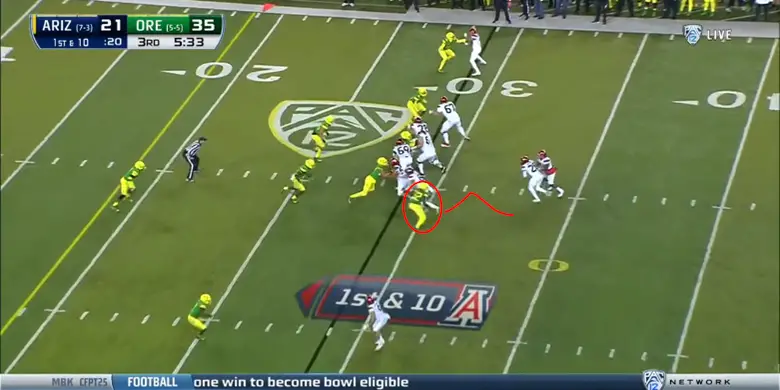
Squeeze-n-Pop: EMLOS “Squeezes” The Cutback Lane. QB Gives.
A key coaching point for the technique is that the defender (above) must keep his shoulders square to the line of scrimmage at all times during the squeeze portion of the technique. If he were to turn his shoulders to the inside, he wouldn’t be able to contain the QB on a pull (keep) read.
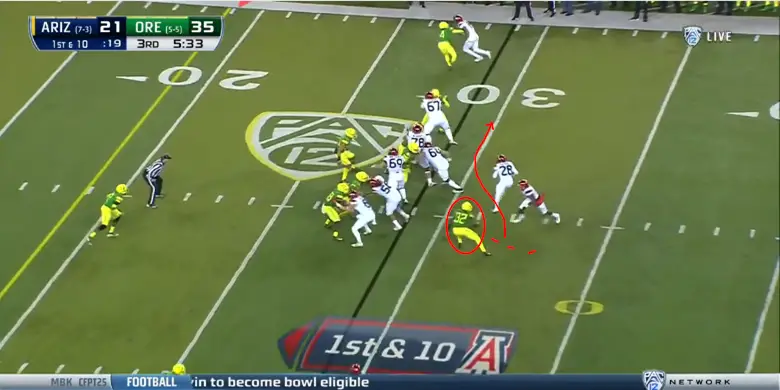
Squeeze-n-Pop: EMLOS “Pops” Out To Contain The QB. RB Has The Ball.
Once the EMLOS (red circle above) confirms the QB has completed the handoff to the RB, he will trail the ball carrier down the LOS. Remember, he is responsible for back side containment. This includes any cutback by the RB after the handoff.
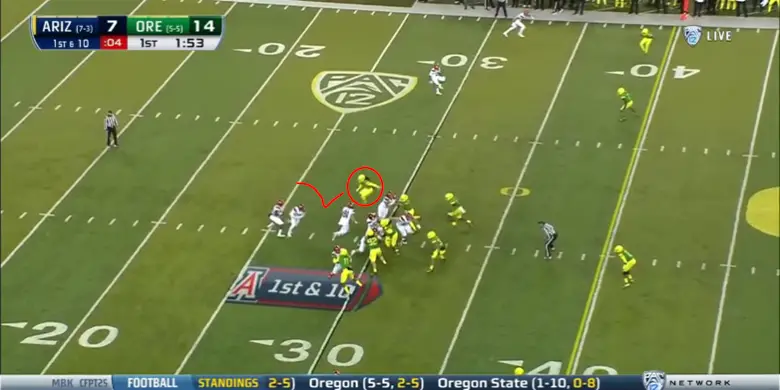
Squeeze-n-Pop: EMLOS “Squeezes” The Cutback Lane. QB Keeps.
A secondary benefit of the Squeeze-N-Pop is that it may force a bad read by the QB. In the above photo, we see that the QB has pulled the ball (keep read) based on the initial path of the EMLOS. From an offensive perspective, quarterbacks are often taught to read the shoulders of the read man. Square shoulders, such as those of the defender in the above example, dictate a handoff (give read). This misread by Tate plays right into Oregon’s hands.
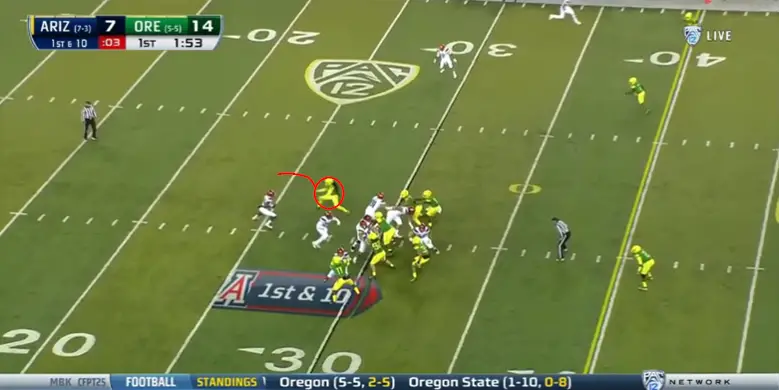
Squeeze-n-Pop: EMLOS “Pops” Out To Contain The QB. QB Has The Ball.
Now that he’s forced a poor read, it’s time for our linebacker to close the deal. In the above screenshot, notice how he has maintained outside leverage and is attacking the QB’s outside shoulder. To effectively execute this scheme against a skilled, dual-threat QB, it takes a true athlete who can match the athleticism of the QB, remain disciplined, and has the ability to make one-on-one tackles in space.
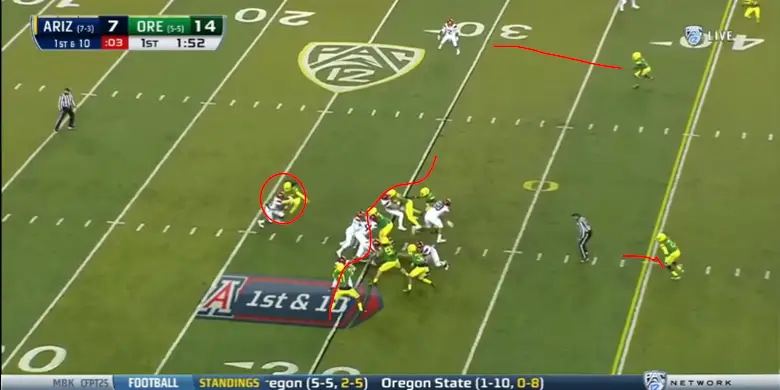
Success: Oregon Has Accounted For All The Run And Pass Options.
This last screenshot above is truly clinic worthy material. The Oregon front seven are all playing aggressive, gap-sound defense with the proper technique and leverage. One additional point of interest, is the deep safety (behind the referee in the above picture) who is utilizing a flat-foot read; he will act as the eraser if an Arizona player were to break through the first two lines of the Oregon defense.
In the above video, you can see why Khalil Tate has been putting up monster numbers on the ground all year. Here, he turns an almost guaranteed loss into a small gain. Oregon did miss a few tackles throughout the game, but overall, they were able to execute the gameplan and slow down a high powered offense.
By constricting the running lanes and actively seeking to defeat blocks, Oregon held the Wildcats to a measly 3.8 yards per carry. This tactic by Defensive Coordinator Jim Leavitt was part of a scheme that was designed to contain Arizona’s dual-threat QB. In this game, Tate struggled both through the air and on the ground, and with their best offensive player struggling, the Wildcats weren’t able to keep pace with the Ducks.
Here at FishDuck.com, we are all excited to see year two of the Coach Leavitt led defense. His focus in year one was clearly on implementing simple schemes and teaching the fundamentals. I expect to see a few more wrinkles added to the defensive playbook next season. I believe the Duck’s defense is truly in great hands.
Zach Pierson
Birmingham, Alabama
Top Photo from Eugene Johnson
Zach enjoys dissecting football gameplans and schemes from the confines of his home office on the outskirts of Birmingham, Alabama. His goal is to provide breakdowns that shed light on the intricacies of football, using simple, easy-to-understand language.

